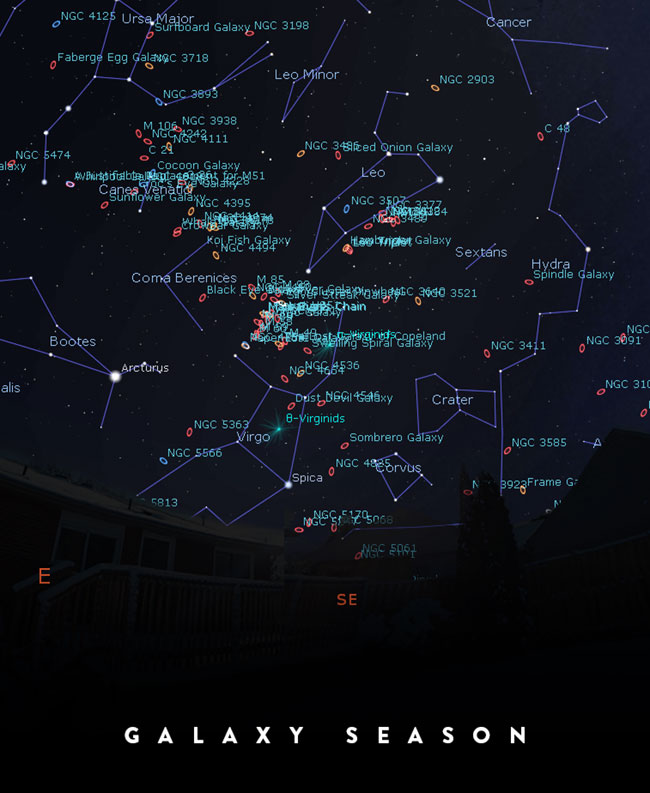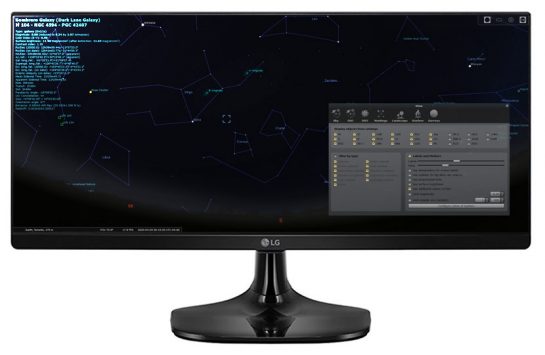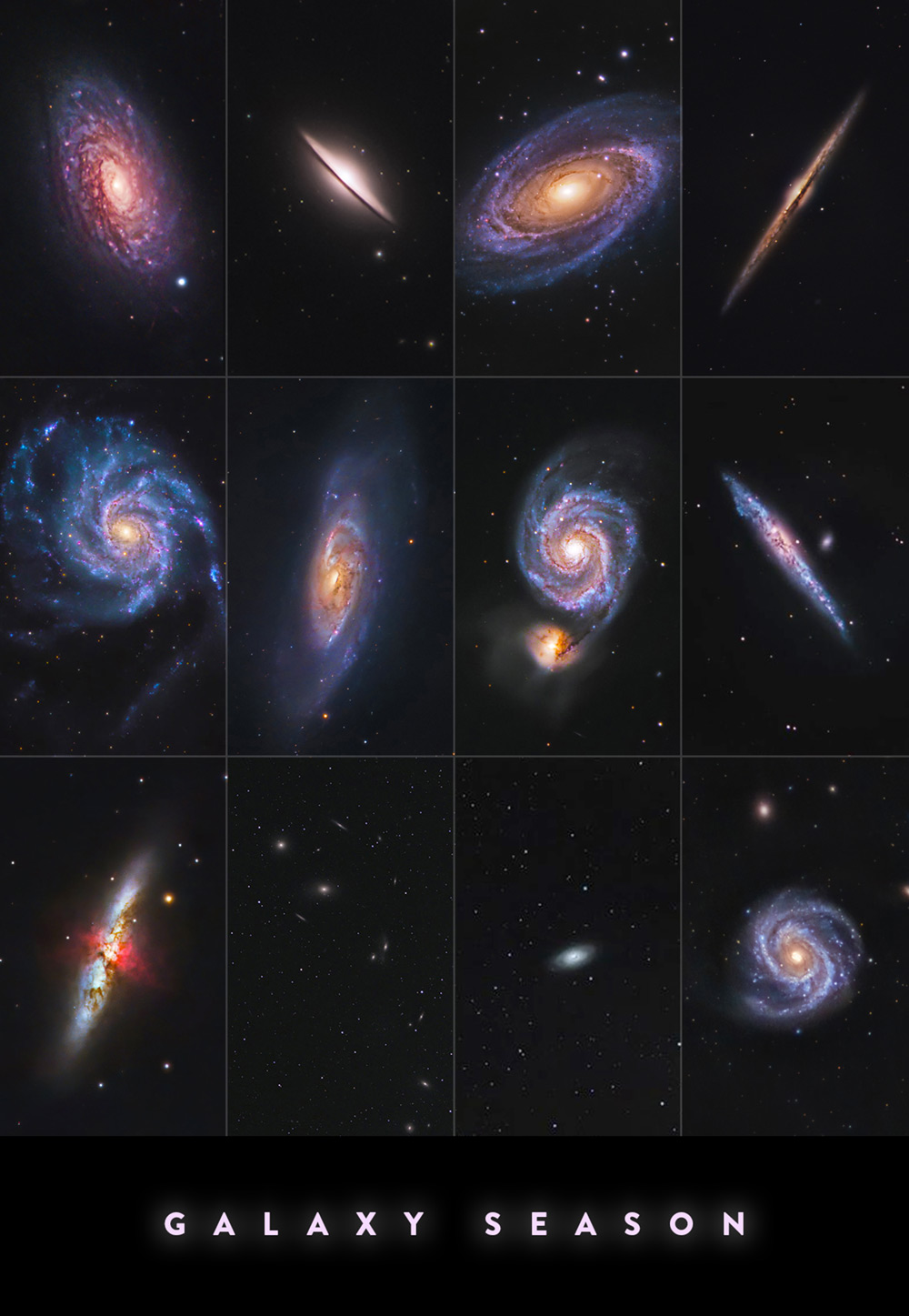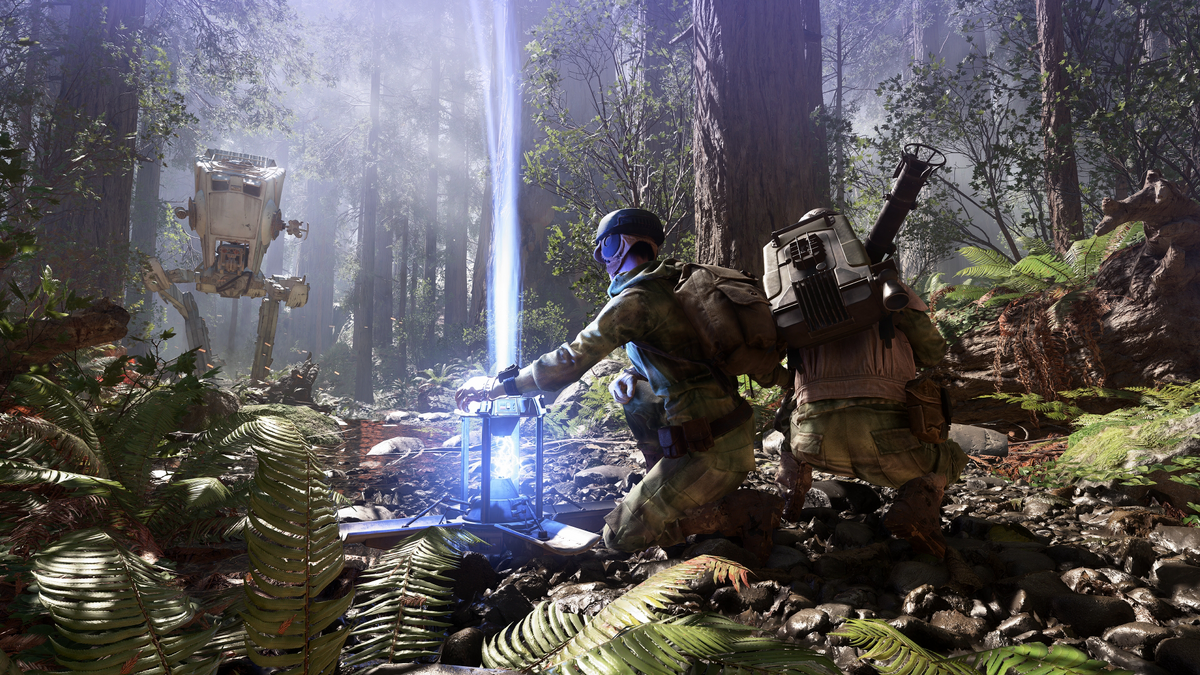In the astrophotography realm, Galaxy Season refers to the period in Spring when the night sky offers up a buffet of incredible galaxies to observe and photograph. From early March until mid-May, the window of opportunity for night-sky enthusiasts to photograph a wide variety of galaxies is at its best.
I don’t know about you, but the idea of photographing another galaxy full of countless stars and unknown worlds makes me feel pretty small (in a good way). This is one of the many amazing feelings experienced by backyard amateur astronomers and photographers alike.
The photos you are about to see were all captured by me, using amateur astrophotography equipment in the city. In this article, I’ll provide a list of promising galaxies that are possible to photograph with almost any telescope. That’s right, you can still photograph galaxies with your DLSR camera and compact refractor, but most targets will appear quite small at focal lengths of 400-800mm.

The Needle Galaxy and Sunflower Galaxy.
Be sure to take a look at the following article for even more inspiration for your next astrophotography project: The Brightest Galaxies in the Night Sky.
Astrophotography in the Spring
Whether you own a large SCT (Schmidt Cassegrain Telescope) or a small refractor, galaxy season is an opportunity to focus on a new array of deep-sky objects that are well-deserving of your attention.
If you are using a telescope or lens with a focal length of 800mm or less, expect most of the galaxies on this list to appear very small. A popular telescope choice for galaxy photography is an SCT, such as the Celestron EdgeHD 11, as it provides a large aperture (11″) and high magnification views (2800mm).
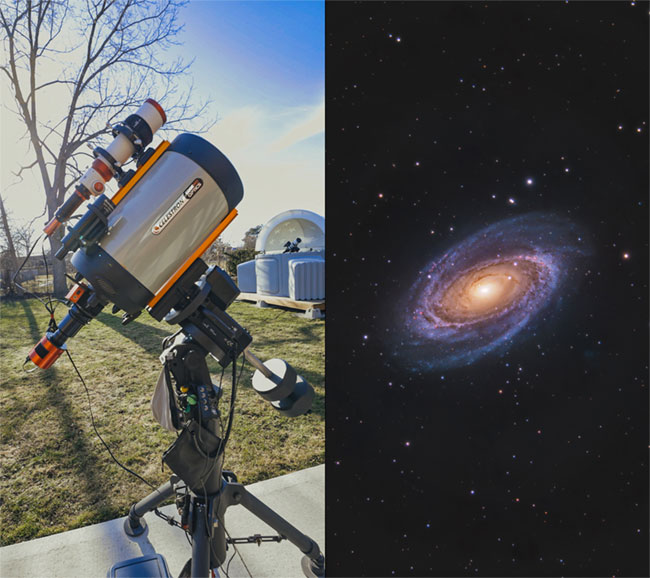
The telescope used to photograph Bode’s Galaxy in Ursa Major.
With that being said, don’t let that stop you from viewing and photographing galaxies this spring using whichever telescope you currently own. Some of the galaxy photos in this article (such as the Black-Eye Galaxy) were captured using a small 80mm refractor telescope from my backyard in the city.
Take one look at your favorite astronomy app, filter the object type by ‘galaxy’ in the planetarium, and you’ll quickly see why amateur astronomers refer to the spring as galaxy season. The screenshot from Stellarium below shows the view looking east/southeast from my backyard (yes, those are all galaxies).
Stellarium view of my backyard – filtered by galaxies.
Why do amateur astronomers and astrophotographers call the time between March and May ‘galaxy season’? The answer is that our own galaxy blocks our view of many galaxies in the night sky, so we can see the most galaxies when we see the least of our own.
This is particularly evident for observers in the northern hemisphere during early spring. The Virgo Cluster is in prime position for observing and imaging by late March, and it is filled with galaxies.
Many of these galaxies appear small and featureless from our vantage point on Earth and do not make great astrophotography targets. Here is a list of the ones that do.
1. The Leo Triplet
Designation: M65, M66, NGC 3628
Magnitude: 8.9 (M66)
Constellation: Leo

The Leo Triplet.
The Leo Triplet is a personal favorite of mine because it offers a view of 3 distinctly different types of galaxies at once. The designation for these galaxies is M65, M66, and NGC 3628. This is one of the best subjects to try if you’re using a telescope with a focal length of 1000mm or less, such as a small refractor.
The photo above was captured from my backyard in March 2019 using a Sky-Watcher Esprit 100 APO refractor telescope. Astronomers refer to the Leo Triplet as the M66 Group. This small group of galaxies lies approximately 35 million light-years from Earth.
2. Bodes Galaxy and the Cigar Galaxy
Designation: M81, M82
Magnitude: 6.94 (M81)
Constellation: Ursa Major
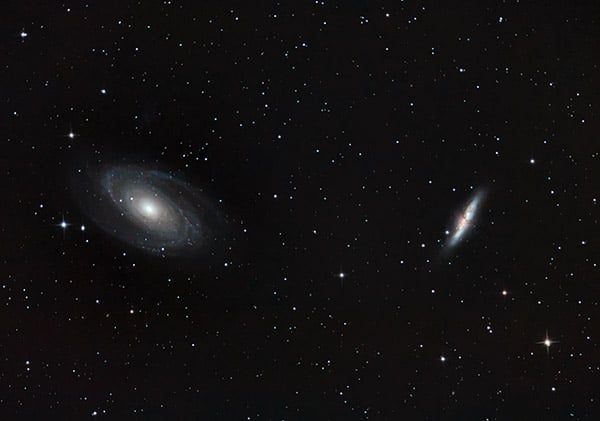
M81 and M82.
I dare you to find a more photogenic pair of galaxies in the entire night sky. These two galaxies are equally as brilliant, and conveniently close together. These factors make M81 and M82 an extremely popular subject for astrophotographers in the northern hemisphere. These galaxies are members of the M81 group, with M81 being the largest galaxy in the group overall.
The photo above was captured using my rarely used Orion 8” F/4 Newtonian. The objects benefitted from the added focal length (800mm), but there is still not enough data acquired to do this pairing justice. Since this photo was taken in 2014, I have captured this pair independently from one another (using a larger telescope) with remarkable results.
Here is a closer look at Bode’s Galaxy captured using a Celestron EdgeHD 11 telescope with a focal length of about 2000mm (using a reducer lens). You can now see some of the fine details and textures of this grand spiral design galaxy in detail.

Bode’s Galaxy (M81).
3. The Pinwheel Galaxy
Designation: M101
Magnitude: 7.86
Constellation: Ursa Major
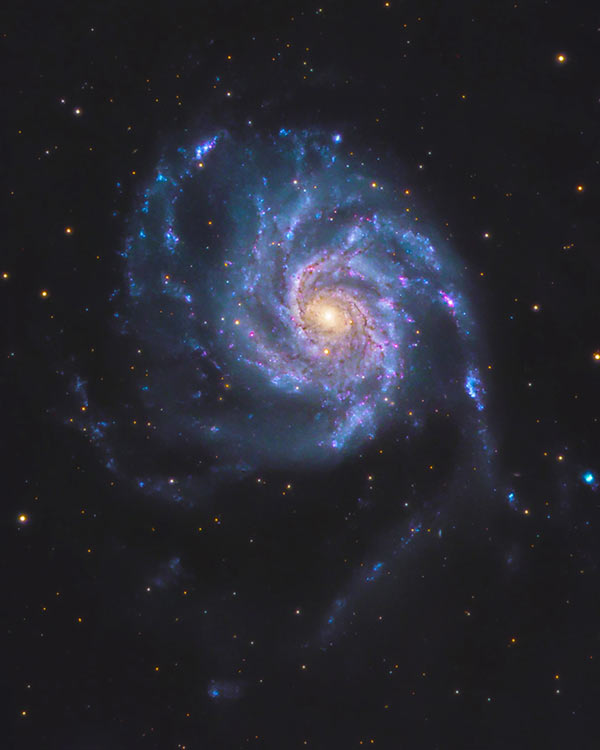
The Pinwheel Galaxy.
The Pinwheel Galaxy, or M101 as it is classified, is a beautiful face-on spiral galaxy located in the constellation Ursa Major. Photographically, the core of the Pinwheel Galaxy is evident even in short exposures. To capture the outer arms, longer, guided exposures are needed.
I have photographed this galaxy many times over the years using several different camera and telescope combinations. The image shown above was created using a large refractor telescope (Sky-Watcher Esprit 150) and LRGB filters from my backyard in the city.
This gorgeous galaxy is located 21 million light-years from Earth. In 2006, NASA and the ESA released this incredible close-up of the Pinwheel Galaxy, which was the most detailed image of a galaxy taken by the Hubble Space Telescope at the time.
4. The Whale Galaxy
Designation: NGC 4631
Magnitude: 9.8
Constellation: Canes Venatici

The Whale Galaxy and Hockey Stick Galaxy.
The Whale Galaxy is quite small when captured through a small refractor telescope. However, the one advantage a wide-field instrument has in this scenario is the ability to capture the nearby Hockey Stick Galaxy (NGC 4656, NGC 4657).
I enjoy the look of this galaxy, as more integrated exposure time adds interesting details and color information reminiscent of the Cigar Galaxy.
I tried photographing this galaxy again in 2017 using a cooled CMOS camera (ZWO ASI294MC Pro) instead of a DSLR. This version is a little better because I used a refractor with more focal length (712mm).
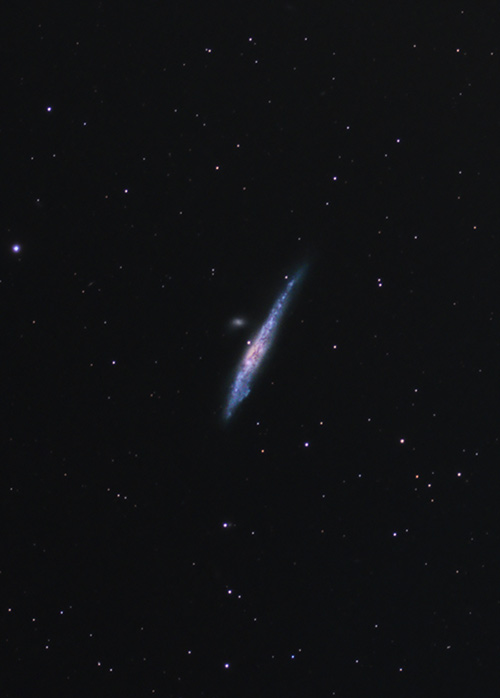
The Whale Galaxy in Canes Venatici.
5. The Whirlpool Galaxy
Designation: M51
Magnitude: 8.4
Constellation: Canes Venatici
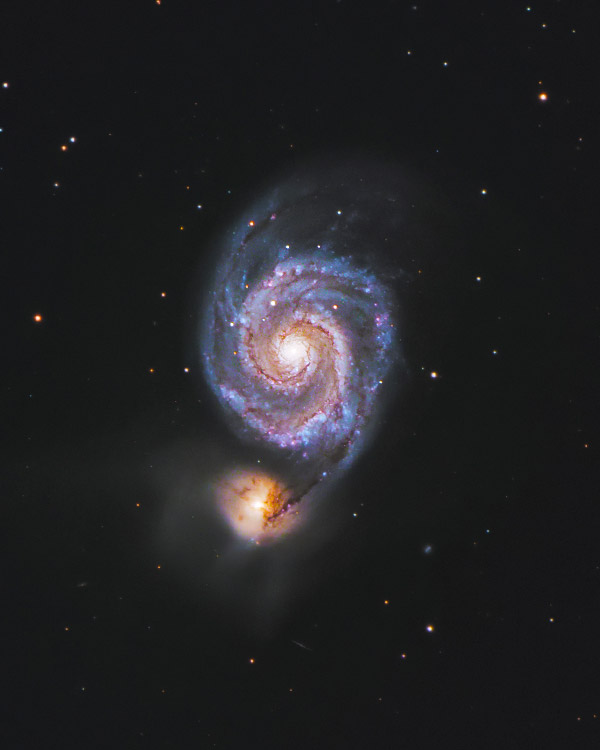
The Whirlpool Galaxy.
The Whirlpool Galaxy is a magnificent sight through a large telescope under dark skies. I have been lucky enough to observe M51 through a 20” Dobsonian telescope under dark skies. The interacting galaxy (NGC 5195) can be distinguished by keen observers.
The Whirlpool Galaxy is classified as an interacting, grand-design galaxy. The image above was created using a Sky-Watcher Esprit 150 refractor telescope on a night that had particularly good seeing conditions.
6. The Needle Galaxy
Designation: NGC 4565
Magnitude: 10.42
Constellation: Coma Berenices
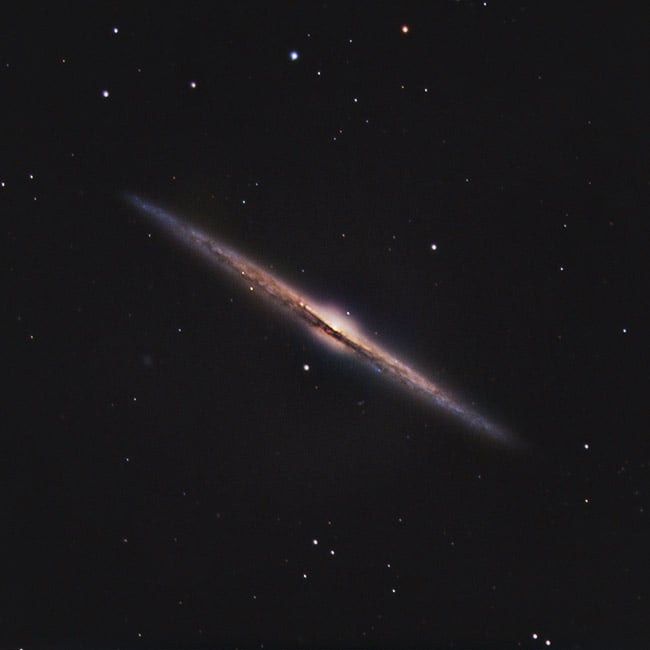
The Needle Galaxy.
This unique edge-on spiral galaxy was the subject of one of my first YouTube videos. This galaxy has a small apparent size, especially through a small telescope.
However, this does not take away from the dynamic presence of this ‘must-shoot’ deep-sky object.
7. The Black Eye Galaxy
Designation: M64
Magnitude: 9.36
Constellation: Coma Berenices
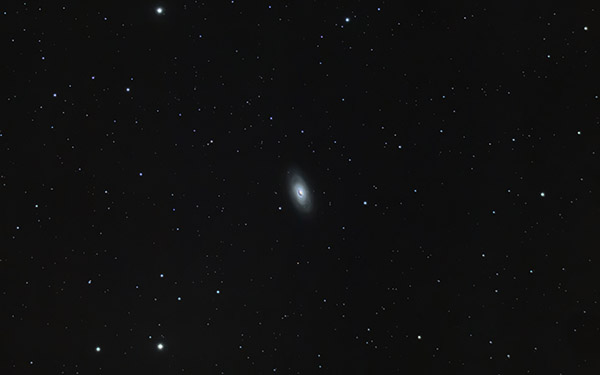
The Blackeye galaxy includes a notable dark band of dust in front of the bright nucleus. This galaxy is in a prime location for visual or photographic observation in the spring.
Despite its small apparent size, M64 is a noteworthy target for visual observation in the constellation Coma Berenices.
8. The Sombrero Galaxy
Designation: M104
Magnitude: 8.98
Constellation: Virgo
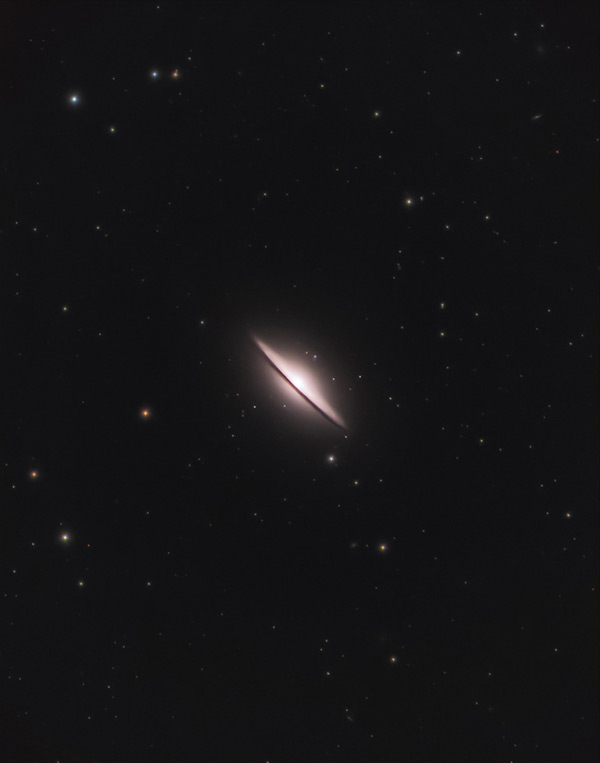
The Sombrero Galaxy.
The Sombrero is widely appreciated due to an iconic photo captured by the Hubble Space Telescope. This unbarred spiral galaxy is located in a vast area of black space in the constellation Virgo. Larger optical instruments are better suited for this small, yet striking galaxy.
I captured my latest image of the Sombrero Galaxy using a Sky-Watcher Esprit 150 telescope with a focal length of 1050mm. This one is very small (9 x 4 arc-minutes), so it is best suited for telescopes in the 1000mm+ focal length range.
It is interesting to note that the Sombrero galaxy is about one-third the size of our own Milky Way Galaxy. With an apparent magnitude approaching 9.0, this deep-sky object is within range of backyard telescopes.
9. M106 and Markarian’s Chain
I couldn’t include every galaxy in this list of targets for galaxy season, but here are two subjects worth checking out. Messier 106 (or NGC 4258) is another fantastic subject for galaxy season. It is an intermediate spiral galaxy in the constellation Canes Venatici.
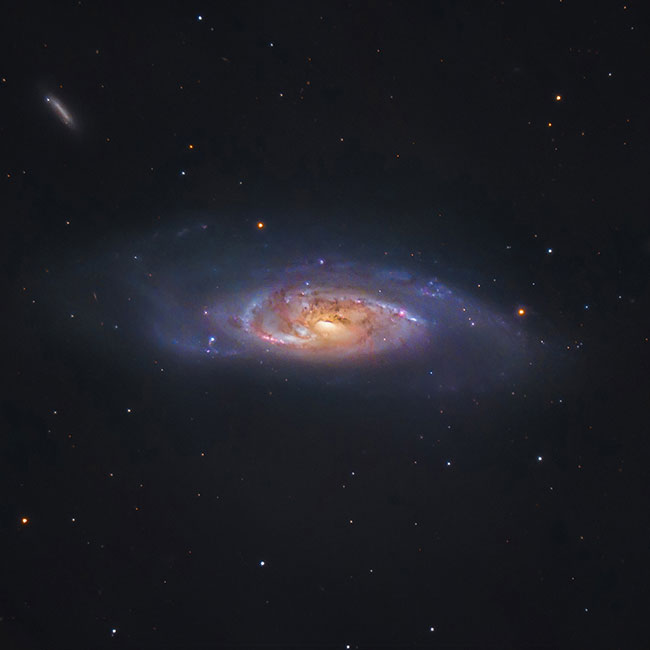
Messier 106.
Another fascinating subject to observe and photograph this galaxy season is Markarian’s Chain. This is a stretch of galaxies located in the constellation Virgo and forms part of the Virgo Cluster.
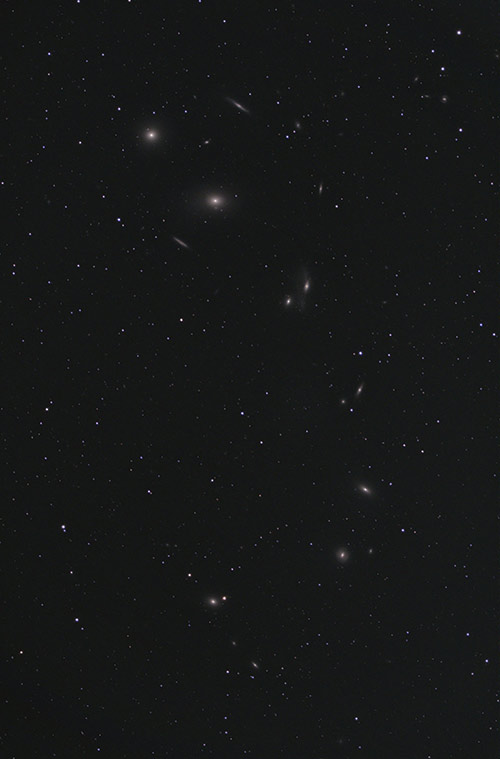
Markarian’s Chain of galaxies in Virgo.
Below you will find the video I created sharing the 8 galaxy season targets mentioned above:
How to Find Galaxies to Photograph
I like to use a planetarium software called Stellarium to plan my galaxy season projects. This is free software that allows you to set specific filters catered to your interests.
Stellarium also provides fascinating details about each of the galaxies you find, and key details such as their size, magnitude, and apparent altitude from your location. Be sure to set up your location information properly to ensure you are seeing an accurate representation of the night sky.
Use a planetarium software like Stellarium to plan your projects.
You can also enter your specific camera and telescope information in the sensor view mode, to get a preview of the exact image scale you can expect with your system. You can also try this handy image scale and field-of-view calculator to better plan your galaxy photo.
I hope that this article has assisted and/or inspired your astrophotography endeavors. Every one of the galaxy photos took several hours to capture and process. As I learn new and better ways to produce high-quality images, I will update my collection of images taken during galaxy season.
Resources:
This article was originally posted in March 2017 and updated in March 2024.


